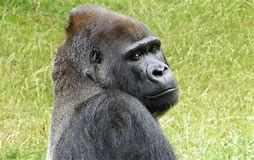Good News for a Change 📽 : Rwanda’s Endangered Mountain Gorillas get a Better Chance
- Jan 26, 2018
- 3 min read
Updated: Apr 4, 2018
Only several hundred mountain gorillas remain on Earth, living on the green, volcanic slopes of Rwanda, Uganda and the Democratic Republic of Congo. Unfortunately, our Great Ape “cousins” have been decimated by human violence (poaching) and loss of habitat. Our inability to take responsibility for these amazing animals, recognising their right to exist, almost led to the species’ extinction. At present, they remain listed as critically endangered.
Remaining populations are assisted by various conservation initiatives; as a result, it is believed that their numbers are slowly and steadily increasing. Just in time. Nevertheless, the dual threats of habitat loss and the lucrative poaching trade remain a major threat.

Mountain Gorilla Habitat (n-cdn-origin.areyouahuman.com)

Gorilla mother with baby

Mountain Gorilla (Gorilla beringei beringei)
On the subject of positive developments, it is great to be able to report that the Rwanda Development Board received this month (January 2018) 27.8 hectares from the African Wildlife Fund (https://www.awf.org/), to be added to the 16,000 hectare Volcanoes National Park. This additional habitat should allow gorilla numbers to rebound, along with a wide range of other species.
The original news brief may be found here:
“On Wednesday, January 10, the Rwanda Development Board (RDB) received a property that will help increase the size of Africa’s oldest park – Volcanoes National Park. Established in 1925, the park is home to mountain gorillas, the world’s most endangered ape, and is situated in the north of Rwanda bordering the Democratic Republic of Congo and Uganda.” - Report of the African Wildlife Fund (www.awf.org/news)
This most critically endangered species of all apes deserves all the help it can get. Here are 10 fascinating facts about the Mountain Gorilla:
Gorillas share human DNA. "The big picture is that we're perhaps 98 percent identical in our sequences to gorillas. So that means most of our genes are very similar, or even identical to, the gorilla version of the same gene," said Chris Tyler-Smith, a geneticist at Wellcome Trust. Source: https://news.nationalgeographic.com/news/2012/03/120306-gorilla-genome-apes-humans-evolution-science/
Mountain gorillas live only in Africa, distributed into two populations
Some primatologists consider the Bwindi gorilla population in Uganda as a separate subspecies (there is however no conclusion to ascertain this)
Mountain gorillas are as shy as they are strong
Mountain gorillas live in groups of up to 30
Aged male gorillas are called silverbacks
The silverback gorillas ensure protection of the group
Female mountain gorillas can start reproducing from the age of ten
Mountain gorillas are herbivores
They live between 40 to 50 years
An adult gorilla is about 1 meter tall to their shoulders when walking on all fours using their arms and their legs. “Males, at a mean weight of 195 kg (430 lb) upright standing height of 150 cm (59 in) usually weigh twice as much as the females, at a mean of 100 kg (220 lb) and a height of 130 cm (51 in).” (Wikipedia, 2018) https://en.wikipedia.org/wiki/Mountain_gorilla#Physical_description

Silverback gorilla

Gorilla family (AfricaGeographic.com)
Since the discovery of the mountain gorilla subspecies in 1902, its population has endured years of war, hunting, habitat destruction and disease. The many threats were so severe that, sadly, it was once thought the species might be extinct by the end of the twentieth century.
Oh, what a tragedy it would have been to lose such a majestic, wondrous creature from our world. Once gone, they are gone forever. And, in losing them, we not only impoverish our world in ways that truly matter, we also lose a piece of ourselves. We must find in our hearts and in our minds, the space to coexist with our fellow travelers, on this pale blue dot.
📽 Please take the time to watch this beautiful short documentary:
“The Mountain Gorillas of Rwanda, Africa” [7:10]
References
African Wildlife Foundation, 2018 (viewed 25.01.2018)
AG-Africa Geographic, April 2017 (viewed 25.01.2018)
Wikipedia






Comments